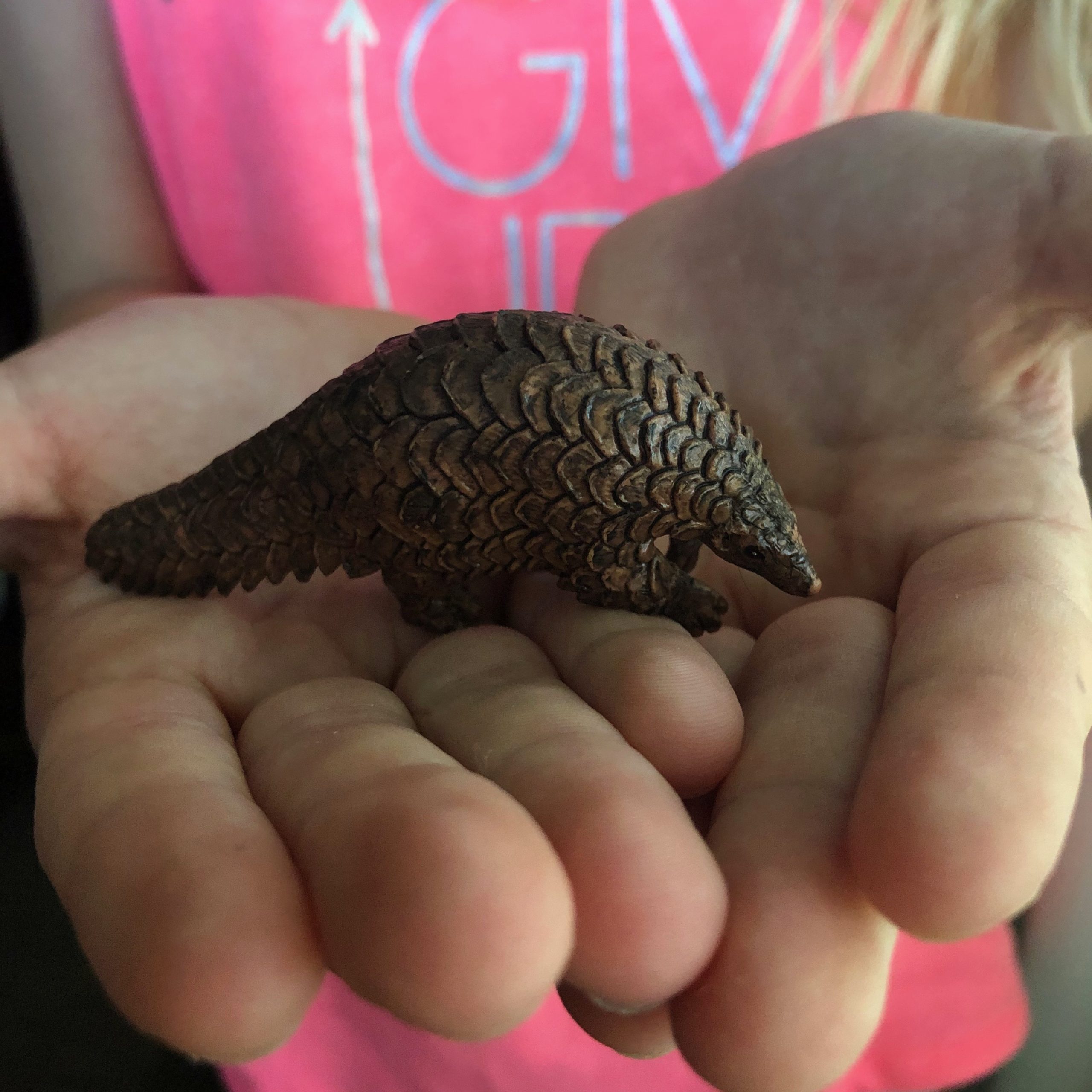
Pangolins, and Zoos, and Surprises… Oh My!
Have you ever planned a surprise for someone and it took everything you had inside NOT to spill the beans? What if that surprise had something to do with a zoo and your child’s favorite animal… a pangolin? I can picture the look on some of your faces right now; “What is a pangolin?!”
❤️ A huge thank you to Brookfield Zoo for hosting us on our visit… and for making dreams come to life. ❤️
If you don’t know what a pangolin is, don’t worry, you’re not alone. Many people have never heard of them either. Pangolins are the most trafficked mammal in the world and they are being trafficked at a higher rate than rhinos, elephants, and tigers COMBINED.
Let that sink in for a minute… COMBINED?! If that’s true, why have so many people never even heard of them before?
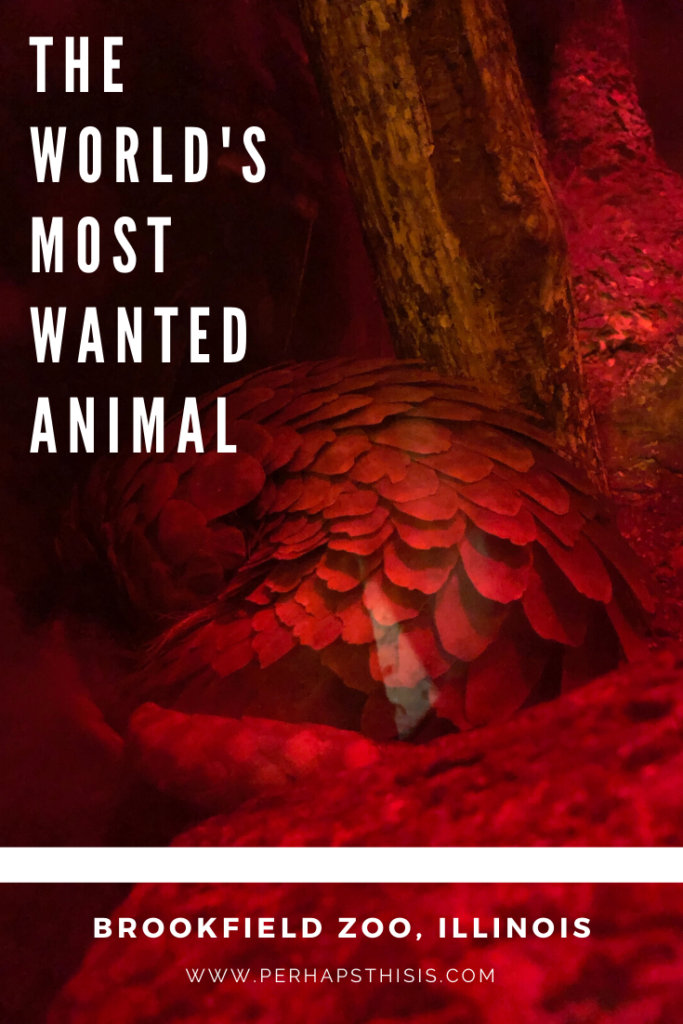
This post may contain affiliate links and we may earn compensation when you click on the links at no additional cost to you.
What is a pangolin?
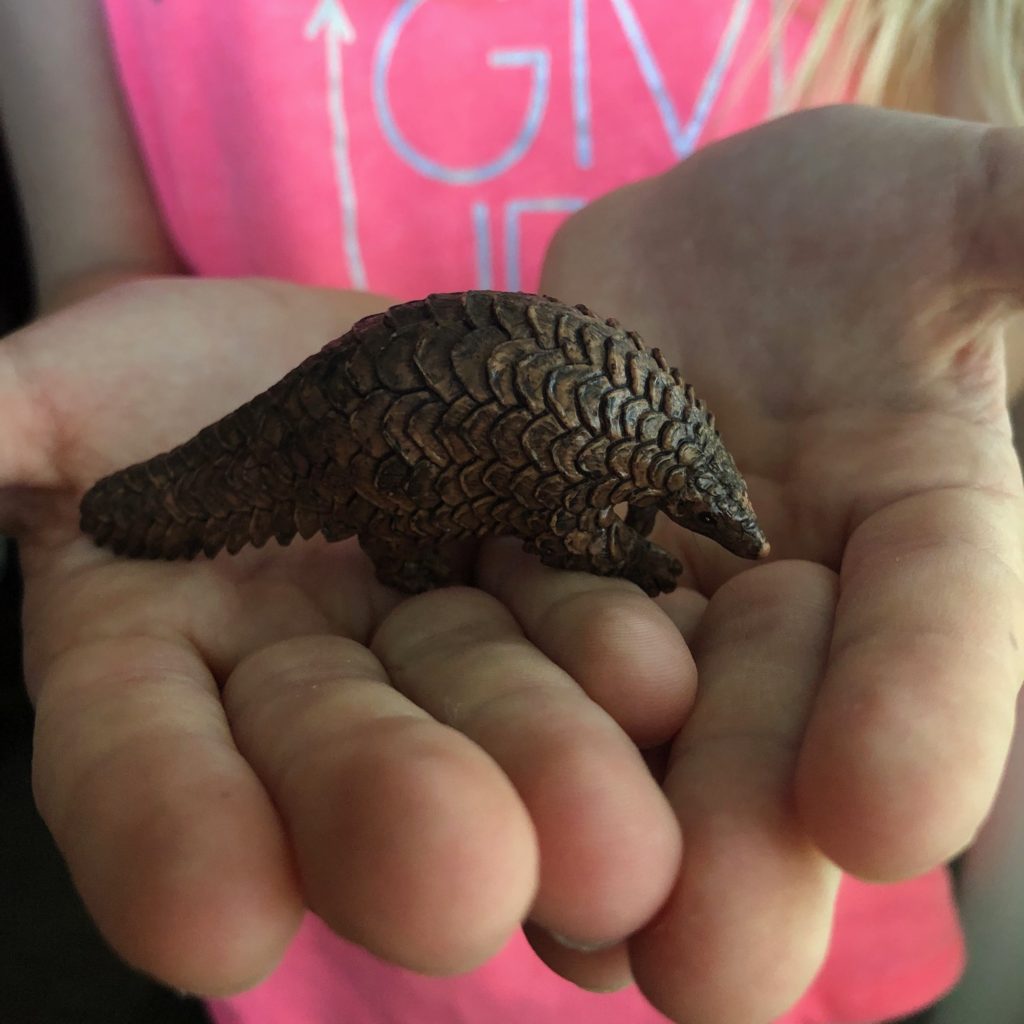
Despite their scaly appearance, pangolins are actually mammals, not reptiles, and they have existed for over 40 million years. There are eight different types of pangolins, with four in Africa and four in Asia:
- Africa – Temminck’s Ground Pangolin, Giant Ground Pangolin, White-bellied Tree Pangolin, and Black-bellied Pangolin
- Asia – Indian Pangolin, Philippine Pangolin, Sunda Pangolin, and the Chinese Pangolin
Also known as “scaly anteaters,” a pangolin’s diet consists of ants and termites that they catch with their long, sticky tongues. It is believed that their tongue is as long as their bodies!
Tree pangolins live in hollow trees and climb on all four feet, whereas ground pangolins live in burrows and walk on their two back legs, a lot like a dinosaur.
All eight pangolin species range from vulnerable to critically endangered and they are protected under national and international laws. But that has not stopped the massive international illegal trade in pangolins around the world.
So why are they endangered?
Pangolins are covered in a “shield” of scales, made of keratin just like your fingernails and hair. Some cultures around the world wrongly believe that their scales have medicinal benefits and their meat is considered a delicacy.
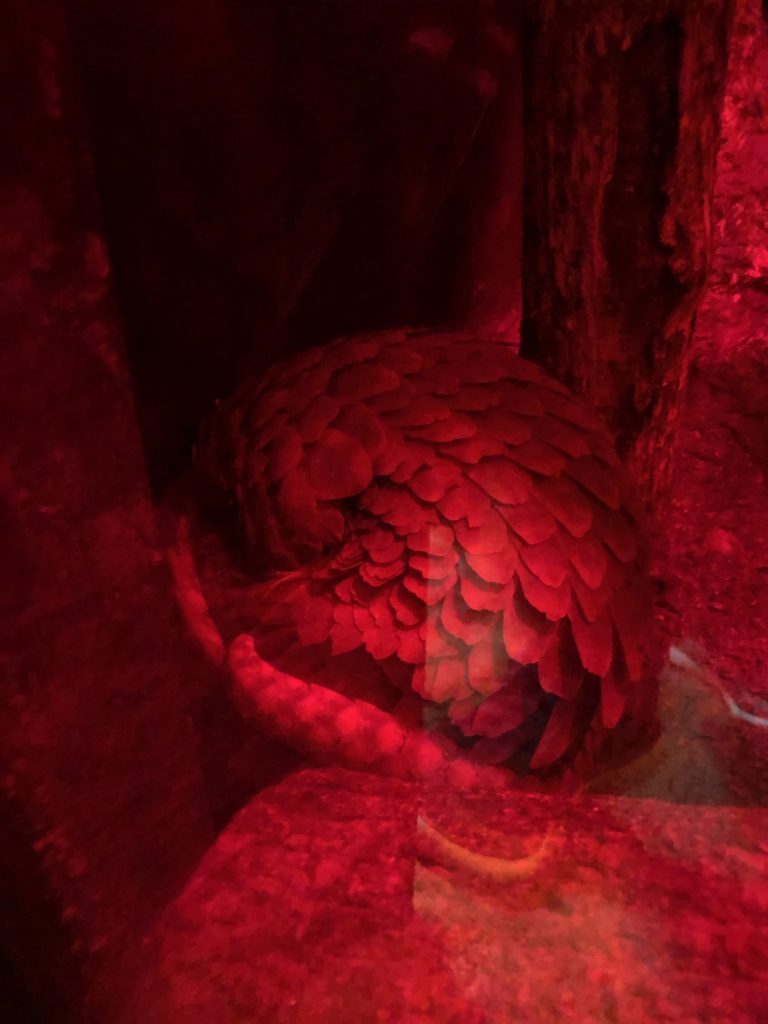
Since pangolins are “shy,” their only defense against predators like lions, and hyenas, is to curl up in a ball. Their name comes from ‘penggulung,’ which is the Malay word which means, “one who rolls up.” After they roll up into a ball, they can ward lions and hyenas off by using the sharp scales on their tail. As for poachers, when the pangolin curls up into a ball, it gives them little defense and makes them extremely easy to catch.
Due to the high demand, about 110,000 pangolins die every year.
That’s one pangolin every five minutes.
Over a MILLION have been poached within the last 10 years.
During the first few months of 2019, over 40 metric tons (over 88,000 pounds) of pangolin products had been seized. Can you only imagine what that number is now that the year is almost over?
How did it all start?
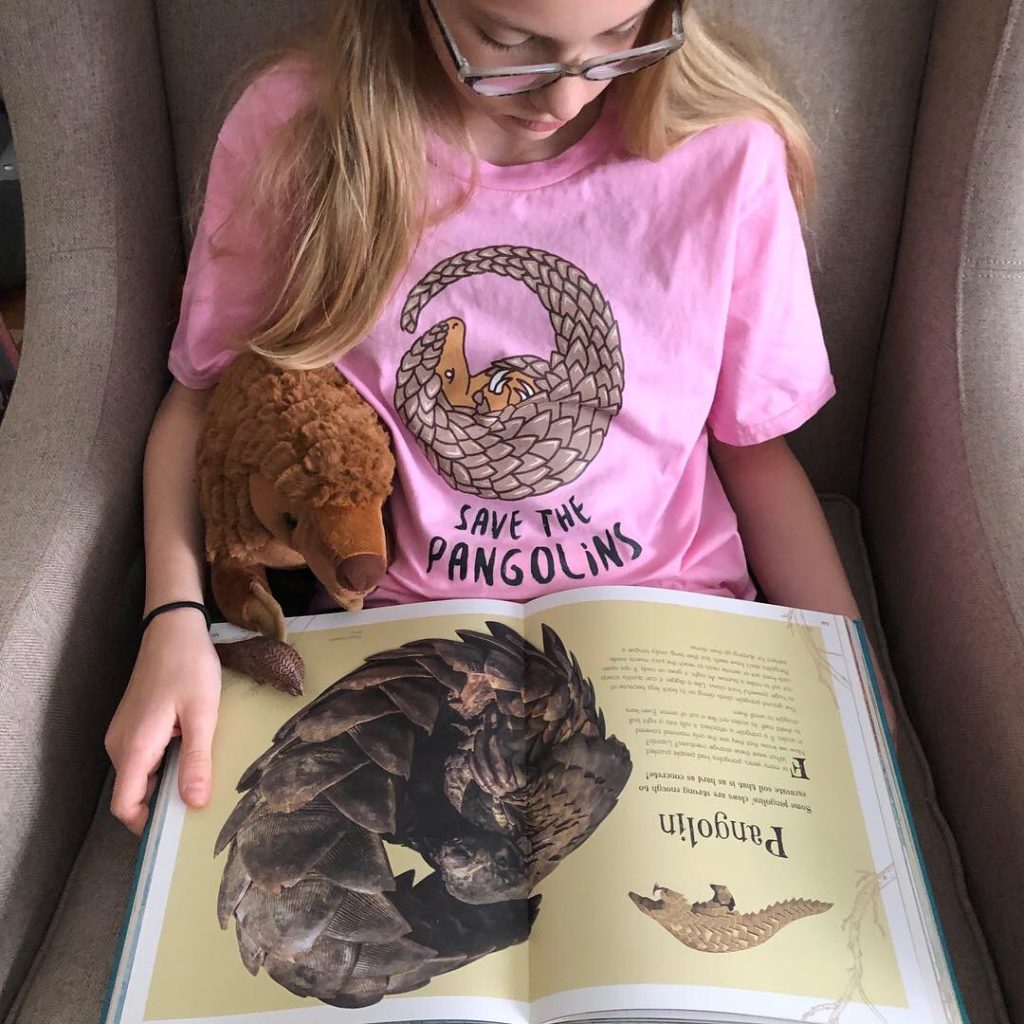
My oldest daughter, Rae’s, love of pangolins started after seeing an episode of PBS Nature titled “The World’s Most Wanted Animal.” It was about the work of Maria Diekmann who started REST Namibia. Maria has devoted her life to saving pangolins in Africa and around the world. You even get to “meet” the first pangolin Maria ever saved, Honey Bun, and see firsthand the extent Maria goes through every day to help pangolins.
After Rae watched that episode, she was hooked. She wanted to learn all about them and even more, she wanted to help save them. Both Rae and her sister, Grace, decided to take part in a homeschool marketplace where the children make items to sell. They thought it was a great idea to donate part of their earnings to REST. Between the two of them they made felt flower pencils, notebooks, chocolate chip cookies, lip gloss, crayons, and even raided our garden at home for produce to sell. They did an amazing job, and sold out of quite a few items.

After we sent our donation to REST, the girls received a personal video message from Maria AND Honey Bun, thanking them for their donation and their commitment to help save pangolins. Maria, Honey Bun, Noelle, & all of the volunteers at REST have left an imprint on my daughters’ hearts that will last them a lifetime. And for that I am forever thankful.
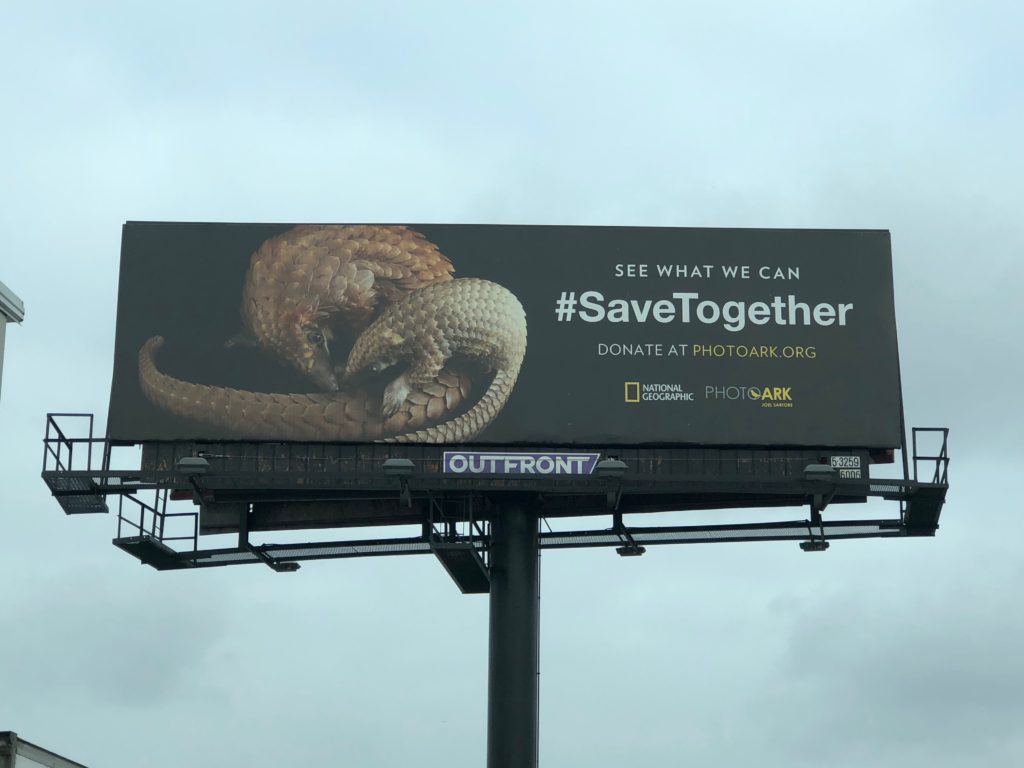
Imagine the girls’ looks on their faces when this billboard went up a mile from our home, just a few weeks after the sale. They were speechless! Must have been a sign from Maria, they thought.
“If you think you are too small to make a difference, you haven’t spent the night with a mosquito.”
African Proverb
So, what is the surprise?!?!
We were lucky enough to receive hosted tickets from the Brookfield Zoo in Brookfield, Illinois, which is a short drive from downtown Chicago. I know, Illinois is NOT Africa, but it’s the next best thing!
Why?!
They actually have a white-bellied pangolin on exhibit!
When I first heard about the pangolin at Brookfield, I started to cry. Here is the animal that my daughter loves, that lives thousands of miles away in Africa, and now we can jump in the car and see it just a couple hours away?! It took everything I had not to tell her.
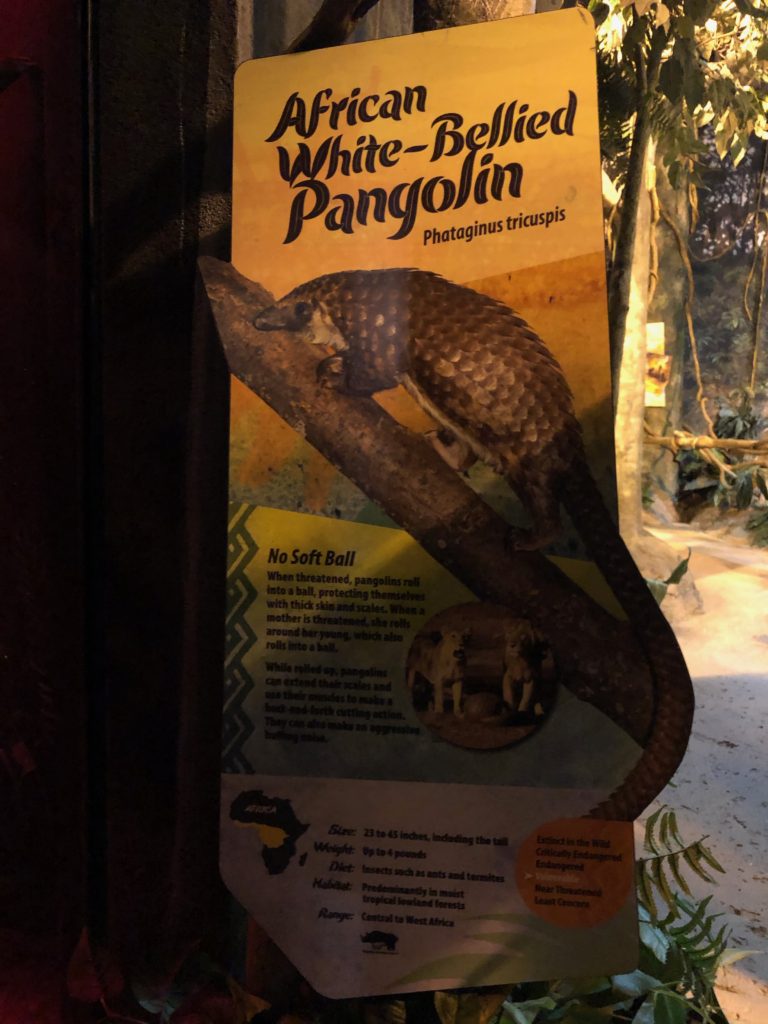
The Brookfield Zoo is one of only two zoos in the United States where you can actually see a pangolin on exhibit. The other being the Memphis Zoo in Tennessee. Interesting fact, the pangolin that is on exhibit at the Memphis Zoo was actually born at Brookfield! How amazing is that!
Due to the joint effort of the Chicago Zoological Society and the Pangolin Consortium, the Brookfield Zoo, along with five other zoos in the U.S., have joined together to learn more about these animals and figure out what we can do to save them. They also work together with a local university in Togo to further the education, and conservation, of pangolins back in their native country.
It’s so hard to keep a secret!
About two and a half weeks before our visit, I had contacted the zoo and explained my daughter’s love of pangolins. I was put in touch with a wonderful lady who went out of her way to not only make our visit an exciting one, but also an experience that my family will always remember.
Not only were we going to see the pangolin exhibit but we would also get the opportunity to talk with an animal care specialist that takes care of the pangolins!
The big moment!
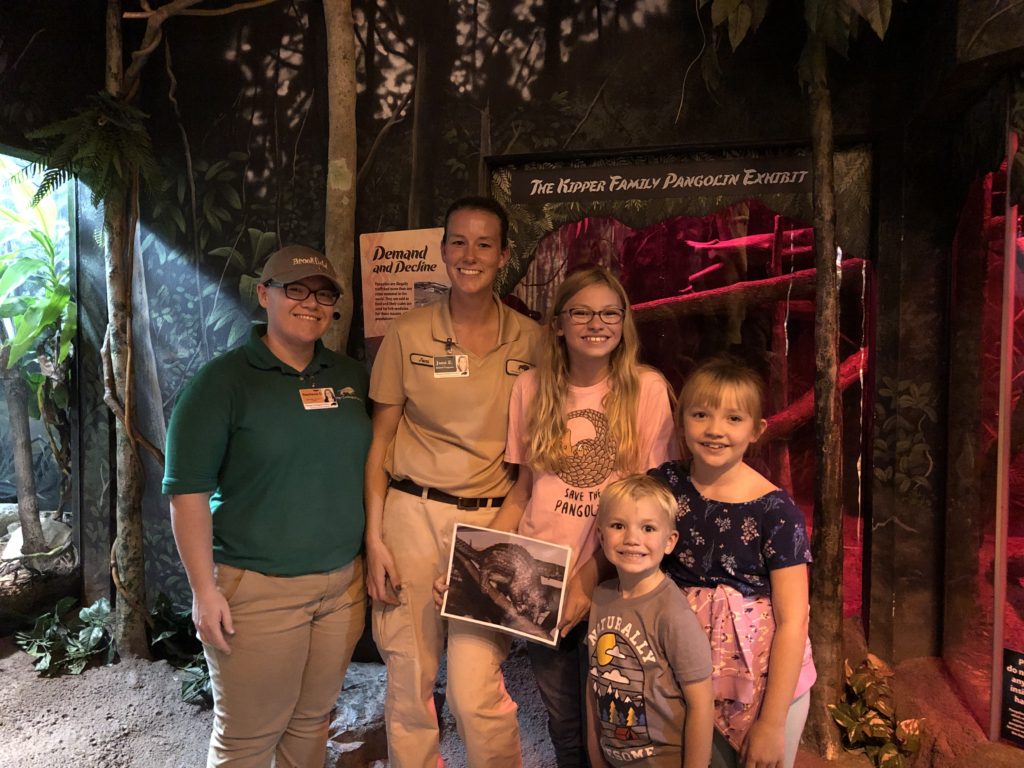
We met Jami (R) and Stephanie (L) in a section of the zoo called “Habitat Africa! The Forest” during the pangolin’s feeding time. Since they are nocturnal, and sleep most of the day, they are most active during feeding times.
Biggie, the pangolin in the exhibit, woke up right after we walked up. The red light in the exhibit is to mimic nighttime and since pangolins don’t have very good eyesight, they use their sense of smell to help them get around. You can see him sniffing around in the video above.
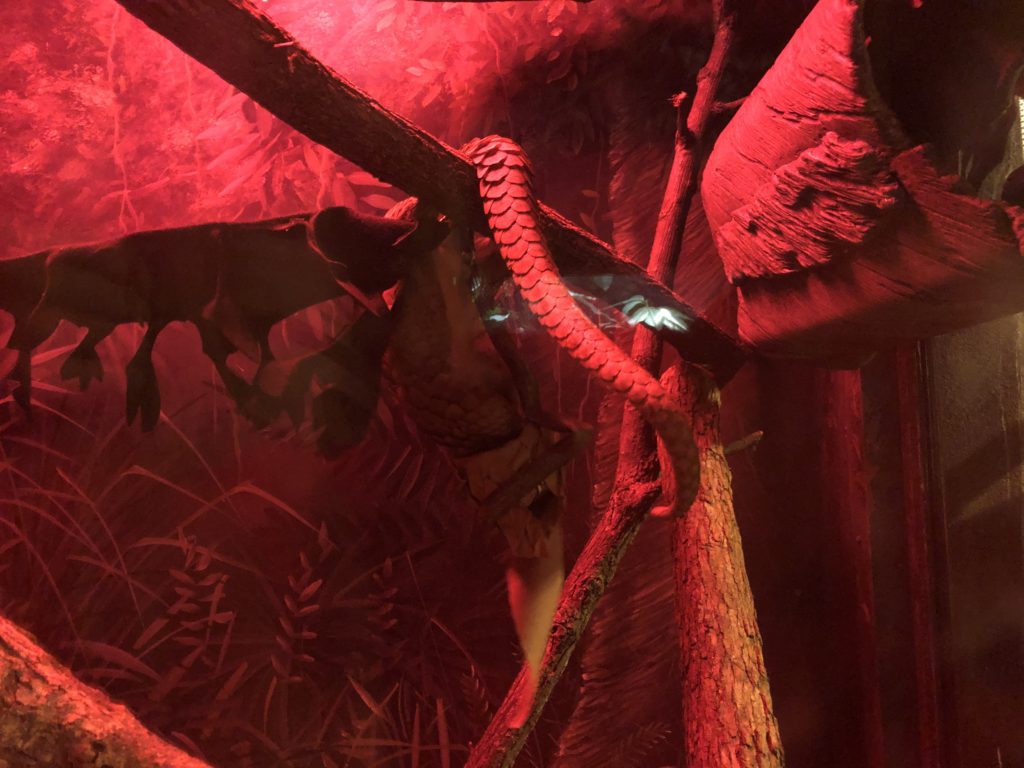
Biggie is the only pangolin they have on exhibit, the rest are behind the scenes. The group of tree pangolins they received came from the African country of Togo. It was amazing to watch him make his way around climbing the tree like a bear, and using his tail to wrap around a branch while he ate.
Jami explained how the caretakers are learning as they go since so little is actually known about pangolins. She explained how they care for them on a day to day basis, and what they feed them. The zoo actually creates different “toys” to feed him with so he can still hunt for his food. Pangolins can eat up to 70 million ants a year!
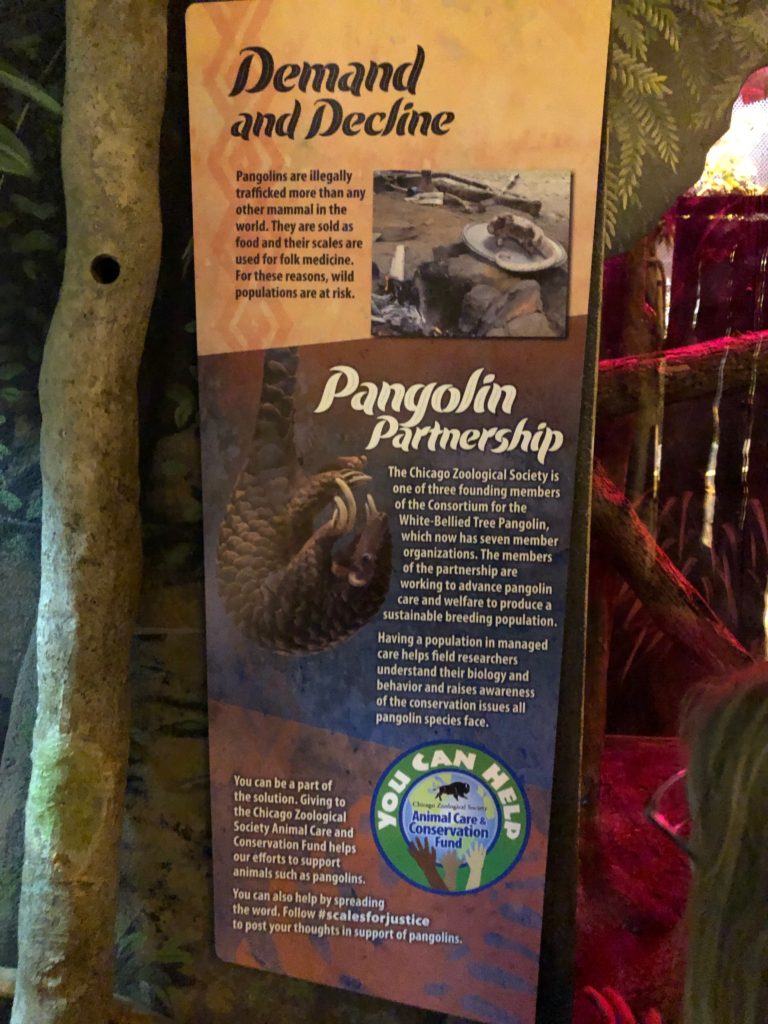
As we stood there in awe just watching him, we learned so much from Jami and Stephanie. Both were so knowledgeable and were absolutely wonderful with my children. Each of them took the time to answer all of my children’s questions… and I mean ALL of my children’s questions!
Dreams do come true!
To be honest, I don’t know who was more excited, my children or me! They all still talk about the wonderful people at Brookfield Zoo and Biggie almost every day. This experience is one that none of us will ever forget. I mean, how often do your wildest dreams actually come true?
So, if you were at the Brookfield Zoo, and saw a mom doing an ugly cry in front of the pangolin exhibit, that was me! Perhaps helping make your childrens’ dreams come true is the best part of being a parent.
Don’t forget to mark your calendar, World Pangolin Day is the 3rd Saturday in February. Help spread the word about these amazing animals that need our help to survive.
Check out our other animal inspired adventures:
- The Ultimate Guide To Brookfield Zoo (Brookfield, IL)
- Bradenton Beach Marina Dolphin Eco Tour (Anna Maria Island, FL)
- Happy Paddler Kayak Coastal Island Tour (Anna Maria Island, FL)
- Mote Marine Laboratory & Aquarium (Sarasota, FL)
- The Ultimate Guide to ZooTampa At Lowry Park (Tampa Bay, FL)
- Giving Back on Vacation: Hawai’i Wildlife Center (Big Island, HI)
- Maui Ocean Center, Aquarium (Maui, HI)
- Outdoor Discovery Center (Holland, MI)
- SEA LIFE Aquarium (Auburn Hills, MI)
- Ripley’s Aquarium of the Smokies (Gatlinburg, TN)



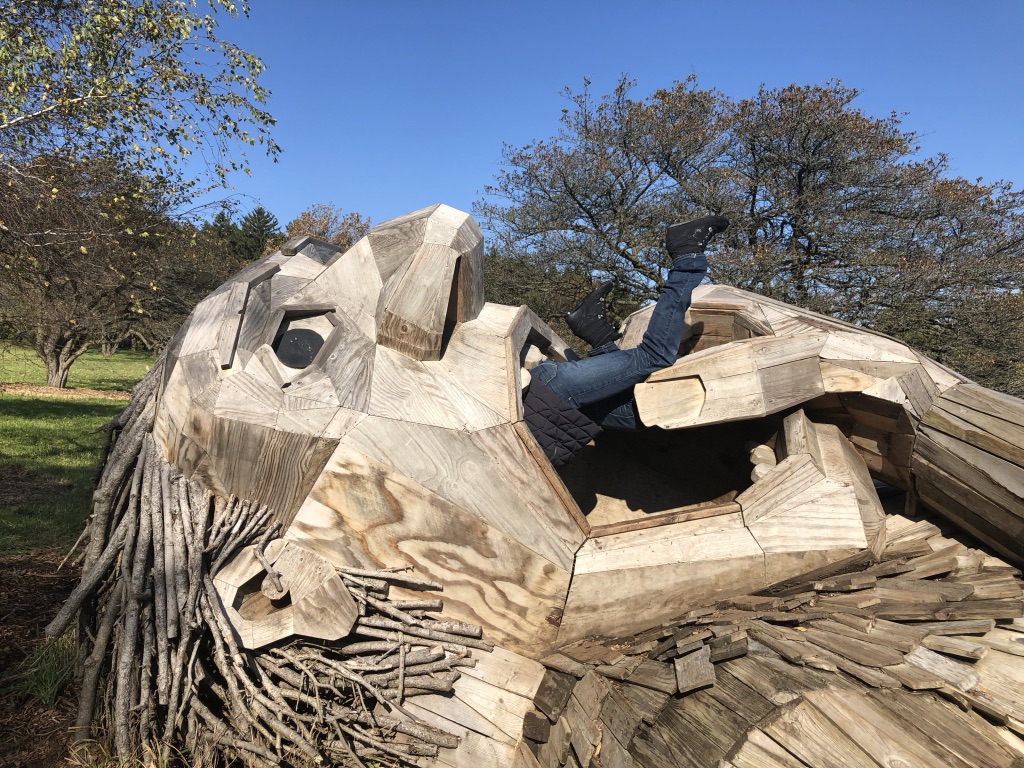
38 Comments
Amanda
Oh my goodness, your girls and their heart for this animal <3 How sweet is it that they took their earned money and donated it?! That is wonderful! I love everything about this post. Thank you for sharing about the pangolin. I had never heard of it before.
Trisha
Thank you, Amanda! My oldest has always had such a love for animals, big or small, ever since she could crawl. She would sit forever and watch ants crawl along the sidewalk. I hope she never loses that passion.
Lee Anne
This is so cool! The Wild Kratts taught us what Pangolins are! What an exciting surprise!
Trisha
Haha! A little five year old boy stopped at the craft sale and said that he knew what they were from Wild Kratts too. He was the only one that day who knew what they were or had heard of them.
Lori
That is so sad that these animals have been trafficked to extinction!
Trisha
It’s very sad. I wish there was no such thing as a black market for animals.
Lori Nielsen
This is so sweet! I love that your daughters worked so hard for a cause that they cared about. And then to get rewarded with the Zoo visit; it’s just so perfect! Good job mom!
Trisha
Thank you, Lori! They are amazing children and I am so lucky they are mine!
Pam
I love this so much! What an amazing experience for all of you.
Trisha
Thank you, Pam. It is something that none of us will ever forget!
Elaine McDermott
I must have been meant to find You and your wonderful girls! I too fell in love with pangolins when I first became a volunteer Docent at Turtle Back Zoo in 2019 and our coordinator said to watch the show about Honey Bun! Then I got to see one up close and cried I support the efforts to save them so very important bless your girls they have a future ahead helping animals !
Trisha
Hi Pam! Thank you so much for your kind words! My kids received a video message from Maria and Honeybun and they still watch it to this day. Pangolins are incredible creatures and deserve to be protected. Thanks for all you do!
Courtney
What a neat experience! Looks like so much fun!
Trisha
It was an out of body experience for my children! 😉
Leeanne
This is wonderful. I love making kid’s dreams come true. Plus the work both girls did to raise money to help the pangolins is amazing.
Trisha
Thank you so much, Leeanne! They sure know how to make a momma proud!
Lisa
I love that! It is so hard to keep a good secret! I’m glad you made you Childs dream come true! So fun!
Trisha
Usually I am a great secret keeper but this time it was SO hard not to yell it from the roof tops!
jen
This is so cool! I love that the girls are so invested!!!!
Trisha
Thank you so much, Jen!
Brianna
This is such a wonderful post. I had no idea that this was happening. Your daughters seem to have such passion and are making a difference in great strides!
Trisha
Thank you, Brianna!
Jennifer | Me and My Traveling Hat
I never heard of Pangolins before. That must have been so exciting for you to find out they were only hours from you and that you surprised your girls. Good to hear they are passionate about saving them.
Trisha
It was close to an out of body experience when I learned they were at Brookfield Zoo. Here we thought the only places they could be found was Africa and Asia. I have a feeling a lot of trips to Brookfield Zoo will be in my future.
Julie
What a sweet surprise. I’ve not heard of pangolins until you had shared about them. Happy they are making strides to protect them now.
Trisha
We are very happy that people, and organizations, are helping to spread the word and educate people on the importance of trying to save these beautiful animals.
Missy
Such a great dream come true. I enjoyed learning about the pangolins.
Trisha
It was a perfect surprise!
Sheila
Incredible. I’m embarrassed to admit that I had never heard of a pangolin before reading this. Very educational post. Plus, how awesome for your daughter – what a great surprise!
Trisha
Don’t be embarrassed! Many people have never heard of them and that’s why my daughter thinks it’s so important to bring attention to them.
Jordin
AMAZING! My 2nd grade students would love to learn about this animal. We always do Fun Fridays and this will be a great topic!
Trisha
What an awesome idea! I hope they enjoy pangolins also!
Wendy Robinson
Pangolins are super cute. Now I want one
Trisha
Us too! They are absolutely adorable!
Hera
Super cute! I don’t have to have one but I don’t want them extinct! I hate seeing they’re endangered, but glad you guys got to see one before they are.
Trisha
They are really cute! We hope that they will be taken off the endangered list someday.
Jami
Trisha, I’m so happy you and your family came to visit. It’s amazing to see kids so inspired about nature and conservation so early in life, and it makes me excited to know that we will continue to have such passionate people joining the field. I’m glad Rae enjoyed the chat as much as I did. Thank you so much for your kind note. I gave Biggie one of the super soft towels the other day and he curled right up in it to sleep!
Trisha
Thank you so much, Jami! Our children are passionate about animals because of people like YOU. Being able to meet someone who has dedicated their life to the care and conservation of animals they love, is life changing to them. We are so happy that Biggie enjoyed the towels. Hopefully he can share with the others.
Thank you again for taking the time out of your day to talk with us about Pangolins. We hope to see you again soon in 2020!